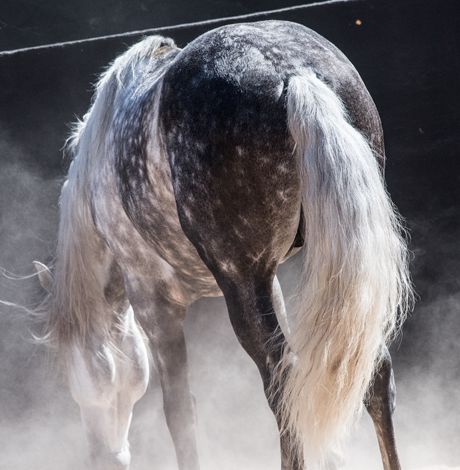
Actually, there is hardly any part of the horse's body that it does not use for communication. This also includes the tail! The horse's health can also be read from the tail and its hair.

If the tail is loose and swings slightly back and forth, the horse is happy and balanced.
Actually, there is hardly any part of the horse's body that it does not use for communication. This also includes the tail! The horse's health can also be read from the tail and its hair. If the horse's hair, like the coat, is beautiful and shiny, the four-legged friend feels good all around. The density, colour and length can also be an indicator. The tail therefore plays a major role for the horse, but also for communication with other members of its species and with humans.
The tail does not begin with the hair, but with the rump. The rump itself consists of up to twenty vertebrae and represents the end of the spinal column. The horse's tail itself is therefore attached to the tail rump and the muscle that moves the tail. In healthy and well-developed animals, the horse's tail should be almost horizontal and straight. A crooked ponytail can indicate tension that runs all the way down the horse's back. Therefore, a well-groomed horse's tail is just as important as, for example, the posture of the head and neck. If the other muscle parts are relaxed, the horse's tail can be moved effortlessly and the horse can communicate how it feels in an unbiased way.

As already mentioned, the noble four-legged friends show their feelings through the use of their tails. For example, if it hangs down loosely and dangles, the horse is relaxed or even bored. If the tail is slightly raised when the horse is in motion and swings loosely back and forth, the horse is content and balanced, which is why this tail position is explicitly desired when riding.
On the other hand, it is bad if the animal flaps its tail forcefully in an agitated and strong manner, as it signals unwillingness and dissatisfaction. Of course, this movement is also used to scare away flies or other troublemakers - so pay close attention to what other signals the horse is sending in order to understand what is meant.
A tail tucked between the hind legs shows fear and discomfort - similar to a dog, for example. If, however, it is raised steeply and carried like a "flag", the four-legged friend is exuberant and high-spirited or excited.
If a horse is tense, a little massage can work wonders. The tail can be gently stretched and massaged. Small circular movements on the tail relieve tension and the horses love it!
It is also important not to simply brush the horse's hair as with the mane, as hairs can be torn out during this process, but to carefully comb it with the fingers. A comb can also help with the procedure.